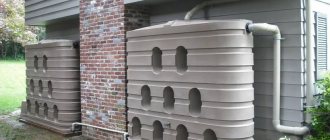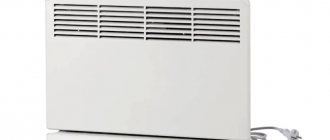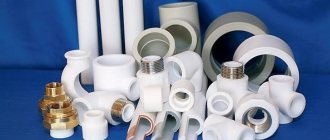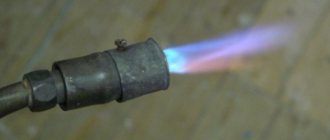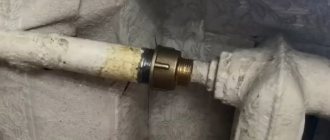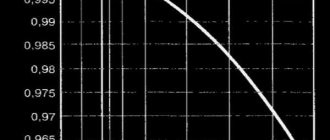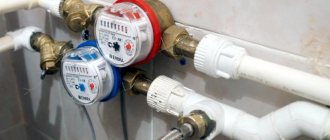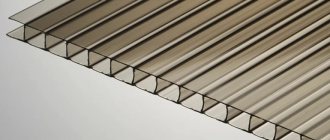The volume of water or coolant in various pipelines, such as low-pressure polyethylene (HDPE pipe), polypropylene pipes, fiberglass-reinforced pipes, metal-plastic pipes, steel pipes, must be known when selecting any equipment, in particular an expansion tank.
For example, in a metal-plastic pipe with a diameter of 16, a meter of pipe is 0.115 g. coolant.
Did you know? Most likely no. And why do you actually need to know this until you are faced with the selection of, for example, an expansion tank. Knowing the volume of coolant in the heating system is necessary not only for selecting an expansion tank, but also for purchasing antifreeze. Antifreeze is sold undiluted to -65 degrees and diluted to -30 degrees. Once you know the volume of coolant in the heating system, you can buy an even amount of antifreeze. For example, undiluted antifreeze must be diluted 50*50 (water*antifreeze), which means that with a coolant volume of 50 liters, you will need to buy only 25 liters of antifreeze.
We present to your attention a form for calculating the volume of water (coolant) in the pipeline and heating radiators. Enter the length of a pipe of a certain diameter and instantly find out how much coolant is in this section.
How to calculate the volume of a heating system?
Each heating system has a number of significant characteristics - rated thermal power, fuel consumption and coolant volume. Calculating the volume of water in a heating system requires an integrated and scrupulous approach. So, you can find out what kind of boiler to choose, determine the volume of the expansion tank and the required amount of liquid to fill the system.
A significant part of the liquid is located in pipelines, which occupy the largest part in the heat supply scheme. Therefore, to calculate the volume of water, you need to know the characteristics of the pipes, and the most important of them is the diameter, which determines the capacity of the liquid in the line. If the calculations are made incorrectly, the system will not work efficiently, and the room will not warm up at the proper level. An online calculator will help you make the correct calculation of volumes for the heating system.
Existing materials for creating water supply networks
Before you calculate the diameter of a pipe for a water supply system, you need to select a material for it. It could be:
- metal (steel, copper, cast iron, their various compounds);
- polymeric materials - plastic, polyethylene, metal-plastic, PVC;
- combinations of metal and plastic structures.
Whatever the characteristics of the materials, the dimensions will also be important. In particular, the diameter of plastic pipes for water supply (metal and metal-plastic too) is divided into external and internal, and the permeability of the pipeline depends on it and the thickness of the walls.
The level of working pressure is also influenced by certain characteristics of the material. In particular, steel is characterized by reliability and strength, but is susceptible to corrosion and is also heavy, making installation of the system difficult. Also, limescale may accumulate inside the steel pipeline - consequently, the diameter will decrease and the permeability of the system will decrease.
Plastic is characterized by low weight, simple and easy installation. Such pipes do not accumulate plaque inside and do not rust; they are inexpensive and flexible. If the pipes are plastic, without a metal layer, then they can expand due to heating, but in metal-plastic products this drawback is eliminated.
Heating system fluid volume calculator
The heating system can use pipes of various diameters, especially in manifold circuits. Therefore, the volume of liquid is calculated using the following formula:
S (pipe cross-sectional area) * L (pipe length) = V (volume)
The volume of water in the heating system can also be calculated as the sum of its components:
V (heating system)= V (radiators)+ V (pipes)+ V (boiler)+ V (expansion tank)
In total, these data allow you to calculate most of the volume of the heating system. However, in addition to pipes, there are other components in the heating system. To calculate the volume of your heating system, including all important heating components, use our online heating system volume calculator.
It is very easy to do the calculation using a calculator. It is necessary to enter into the table some parameters regarding the type of radiators, the diameter and length of the pipes, the volume of water in the collector, etc. Then you need to click on the “Calculate” button and the program will give you the exact volume of your heating system.
You can check the calculator using the above formulas.
An example of calculating the volume of water in a heating system:
An approximate calculation is made based on the ratio of 15 liters of water per 1 kW of boiler power. For example, the boiler power is 4 kW, then the system volume is 4 kW * 15 liters = 60 liters.
Preliminary preparation
There are several options for sealing seams:
- using concrete mortar;
- dry mixture of sand and cement;
- special putty mass.
Each method involves surface preparation. Before starting work, the paving stones are treated with water from a hose under pressure.
If a concrete base is used, the sealing is carried out after 3 days, after the solution has completely dried. Laying tiles on a cement-sand base involves grouting the cracks immediately.
Debris is swept away from the working surface, the distance between the paving stones is cleaned with a thin rod, a compressor or a vacuum cleaner. A jet of compressed air will more effectively and quickly remove excess dirt and speed up the drying of cracks. If there is no compressor, an old vacuum cleaner is used. By installing a tube on the exhaust pipe, a kind of compressor is created. After preparing and cleaning the required area, the grouting method is determined.
Porous materials (ceramic tiles, concrete) are sealed with a dry mixture of cement and sand; materials with a smooth and dense texture (marble, granite) are preferably sealed with concrete mortar. For colored tiles, a ready-made mixture is used.
Values of volumes of various components
Radiator water volume:
- aluminum radiator - 1 section - 0.450 liters
- bimetallic radiator - 1 section - 0.250 liters
- new cast iron battery 1 section – 1,000 liter
- old cast iron battery 1 section - 1,700 liters.
Volume of water in 1 linear meter of pipe:
- ø15 (G ½") - 0.177 liters
- ø20 (G ¾") - 0.310 liters
- ø25 (G 1.0″) – 0.490 liters
- ø32 (G 1¼") - 0.800 liters
- ø15 (G 1½") - 1,250 liters
- ø15 (G 2.0″) - 1.960 liters.
To calculate the entire volume of liquid in the heating system, you also need to add the volume of coolant in the boiler. This data is indicated in the accompanying passport of the device, or take approximate parameters:
- floor boiler - 40 liters of water;
- wall-mounted boiler - 3 liters of water.
The choice of boiler directly depends on the volume of liquid in the heating system of the room.
Internal volume of a linear meter of pipe in liters - table
The table shows the internal volume of a linear meter of pipe in liters. That is, how much water, antifreeze or other liquid (coolant) is needed to fill the pipeline. The internal diameter of pipes is taken from 4 to 1000 mm.
| Inner diameter, mm | Internal volume of 1 m running pipe, liters | Internal volume of 10 m linear pipes, liters |
| 4 | 0.0126 | 0.1257 |
| 5 | 0.0196 | 0.1963 |
| 6 | 0.0283 | 0.2827 |
| 7 | 0.0385 | 0.3848 |
| 8 | 0.0503 | 0.5027 |
| 9 | 0.0636 | 0.6362 |
| 10 | 0.0785 | 0.7854 |
| 11 | 0.095 | 0.9503 |
| 12 | 0.1131 | 1.131 |
| 13 | 0.1327 | 1.3273 |
| 14 | 0.1539 | 1.5394 |
| 15 | 0.1767 | 1.7671 |
| 16 | 0.2011 | 2.0106 |
| 17 | 0.227 | 2.2698 |
| 18 | 0.2545 | 2.5447 |
| 19 | 0.2835 | 2.8353 |
| 20 | 0.3142 | 3.1416 |
| 21 | 0.3464 | 3.4636 |
| 22 | 0.3801 | 3.8013 |
| 23 | 0.4155 | 4.1548 |
| 24 | 0.4524 | 4.5239 |
| 26 | 0.5309 | 5.3093 |
| 28 | 0.6158 | 6.1575 |
| 30 | 0.7069 | 7.0686 |
| 32 | 0.8042 | 8.0425 |
| 34 | 0.9079 | 9.0792 |
| 36 | 1.0179 | 10.1788 |
| 38 | 1.1341 | 11.3411 |
| 40 | 1.2566 | 12.5664 |
| 42 | 1.3854 | 13.8544 |
| 44 | 1.5205 | 15.2053 |
| 46 | 1.6619 | 16.619 |
| 48 | 1.8096 | 18.0956 |
| 50 | 1.9635 | 19.635 |
| 52 | 2.1237 | 21.2372 |
| 54 | 2.2902 | 22.9022 |
| 56 | 2.463 | 24.6301 |
| 58 | 2.6421 | 26.4208 |
| 60 | 2.8274 | 28.2743 |
| 62 | 3.0191 | 30.1907 |
| 64 | 3.217 | 32.1699 |
| 66 | 3.4212 | 34.2119 |
| 68 | 3.6317 | 36.3168 |
| 70 | 3.8485 | 38.4845 |
| 72 | 4.0715 | 40.715 |
| 74 | 4.3008 | 43.0084 |
| 76 | 4.5365 | 45.3646 |
| 78 | 4.7784 | 47.7836 |
| 80 | 5.0265 | 50.2655 |
| 82 | 5.281 | 52.8102 |
| 84 | 5.5418 | 55.4177 |
| 86 | 5.8088 | 58.088 |
| 88 | 6.0821 | 60.8212 |
| 90 | 6.3617 | 63.6173 |
| 92 | 6.6476 | 66.4761 |
| 94 | 6.9398 | 69.3978 |
| 96 | 7.2382 | 72.3823 |
| 98 | 7.543 | 75.4296 |
| 100 | 7.854 | 78.5398 |
| 105 | 8.659 | 86.5901 |
| 110 | 9.5033 | 95.0332 |
| 115 | 10.3869 | 103.8689 |
| 120 | 11.3097 | 113.0973 |
| 125 | 12.2718 | 122.7185 |
| 130 | 13.2732 | 132.7323 |
| 135 | 14.3139 | 143.1388 |
| 140 | 15.3938 | 153.938 |
| 145 | 16.513 | 165.13 |
| 150 | 17.6715 | 176.7146 |
| 160 | 20.1062 | 201.0619 |
| 170 | 22.698 | 226.9801 |
| 180 | 25.4469 | 254.469 |
| 190 | 28.3529 | 283.5287 |
| 200 | 31.4159 | 314.1593 |
| 210 | 34.6361 | 346.3606 |
| 220 | 38.0133 | 380.1327 |
| 230 | 41.5476 | 415.4756 |
| 240 | 45.2389 | 452.3893 |
| 250 | 49.0874 | 490.8739 |
| 260 | 53.0929 | 530.9292 |
| 270 | 57.2555 | 572.5553 |
| 280 | 61.5752 | 615.7522 |
| 290 | 66.052 | 660.5199 |
| 300 | 70.6858 | 706.8583 |
| 320 | 80.4248 | 804.2477 |
| 340 | 90.792 | 907.9203 |
| 360 | 101.7876 | 1017.876 |
| 380 | 113.4115 | 1134.1149 |
| 400 | 125.6637 | 1256.6371 |
| 420 | 138.5442 | 1385.4424 |
| 440 | 152.0531 | 1520.5308 |
| 460 | 166.1903 | 1661.9025 |
| 480 | 180.9557 | 1809.5574 |
| 500 | 196.3495 | 1963.4954 |
| 520 | 212.3717 | 2123.7166 |
| 540 | 229.0221 | 2290.221 |
| 560 | 246.3009 | 2463.0086 |
| 580 | 264.2079 | 2642.0794 |
| 600 | 282.7433 | 2827.4334 |
| 620 | 301.9071 | 3019.0705 |
| 640 | 321.6991 | 3216.9909 |
| 660 | 342.1194 | 3421.1944 |
| 680 | 363.1681 | 3631.6811 |
| 700 | 384.8451 | 3848.451 |
| 720 | 407.1504 | 4071.5041 |
| 740 | 430.084 | 4300.8403 |
| 760 | 453.646 | 4536.4598 |
| 780 | 477.8362 | 4778.3624 |
| 800 | 502.6548 | 5026.5482 |
| 820 | 528.1017 | 5281.0173 |
| 840 | 554.1769 | 5541.7694 |
| 860 | 580.8805 | 5808.8048 |
| 880 | 608.2123 | 6082.1234 |
| 900 | 636.1725 | 6361.7251 |
| 920 | 664.761 | 6647.6101 |
| 940 | 693.9778 | 6939.7782 |
| 960 | 723.8229 | 7238.2295 |
| 980 | 754.2964 | 7542.964 |
| 1000 | 785.3982 | 7853.9816 |
If you have a specific design or pipe, then the formula above shows how to calculate the exact data for the correct flow of water or other coolant.
Online calculation
https://mozgan.ru/Geometry/VolumeCylinder
Main types of coolants
There are four main types of fluid used to fill heating systems:
- Water is the simplest and most accessible coolant that can be used in any heating systems. Together with polypropylene pipes that prevent evaporation, water becomes an almost eternal coolant.
- Antifreeze - this coolant will cost more than water, and is used in systems of irregularly heated rooms.
- Alcohol-containing coolants are an expensive option for filling a heating system. A high-quality alcohol-containing liquid contains 60% alcohol, about 30% water and about 10% of the volume are other additives. Such mixtures have excellent antifreeze properties, but are flammable.
- Oil is used as a coolant only in special boilers, but is practically not used in heating systems, since the operation of such a system is very expensive. Also, the oil takes a very long time to heat up (it needs to be heated to at least 120°C), which is technologically very dangerous; at the same time, such a liquid cools down for a very long time, maintaining a high temperature in the room.
In conclusion, it is worth saying that if the heating system is modernized, pipes or radiators are installed, then its total volume must be recalculated according to the new characteristics of all elements of the system.
What are there and which are better?
According to their structure, polypropylene pipes come in three types:
- Single layer. The walls are completely made of polypropylene.
- Three-layer: fiberglass reinforced - fiberglass threads are sealed between two layers of polypropylene;
- reinforced with foil - the design is similar.
Now briefly about why polypropylene pipes are reinforced. The fact is that this material has a high coefficient of thermal expansion. When heated by 100°C, one meter of single-layer pipe becomes 150 mm longer. This is a lot, although no one will heat them that much, but even at lower temperature deltas the increase in length is no less impressive. To neutralize this phenomenon, compensation loops are installed, but this approach does not always save.
Types of expansion joints for polypropylene pipes
Manufacturers found another solution - they began to make multilayer pipes. They lay fiberglass or aluminum foil between two layers of pure propylene. These materials are not needed for strengthening or any other purposes, but only to reduce thermal elongation. If there is a layer of fiberglass, the thermal expansion is 4-5 times less, and with a layer of foil - 2 times. Compensation loops are still needed, but they are installed less frequently.
On the left is a fiberglass-reinforced pipe, on the right is a regular single-layer pipe
Why is reinforcement made with both fiberglass and foil? It's a matter of operating temperature range. Those with fiberglass can withstand heat up to 90°C. This is enough for hot water supply, but not always enough for heating. Polypropylene pipes reinforced with foil have a wider temperature range - they can withstand heating of the environment up to +95°C. This is already enough for most heating systems (except those with solid fuel boilers).
Which PPR pipes are suitable for which systems?
Based on everything said above, it is clear which polypropylene pipes are better for heating - those reinforced with foil, if high-temperature operation of the system is expected (from 70 ° C and above). For low-temperature heating systems, glass fiber reinforced products can be used.
Any PPR pipes are suitable for cold water supply, but the most rational solution is ordinary single-layer pipes. They cost quite a bit, and the thermal expansion in this case is not so great, one small expansion joint for the water supply in an average private house is enough, but in an apartment, with a small length of the system, they don’t make it at all, or rather they make an “L”-shaped one.
An example of a polypropylene water pipe
To install a hot water supply system, it is best to take polypropylene pipes with a fiberglass reinforcing layer. Their qualities are optimal here, but they can also be used with a foil layer
Please note that compensators are required
Which ones are easier to install?
When deciding which polypropylene pipes are better, pay attention to such a parameter as the complexity of installation. All types are connected by welding, and for turns, branches, etc.
fittings are used. The welding process itself is identical for all types, the difference is that in the presence of aluminum foil, pre-treatment is required - it is necessary to remove the foil to the soldering depth.
This is what the external reinforcement of a polypropylene pipe with foil looks like
In general, there are two types of aluminum reinforcement - external and internal. With the outer one, the foil layer is close to the outer edge (1-2 mm), with the inner one the reinforcing layer is located approximately in the middle. It turns out that it is filled with an almost identical layer of polypropylene on both sides. In this case, preparation for welding also consists of removing the outer layer of propylene to the entire depth of welding (and the foil too). Only under these conditions can the required seam strength be achieved. All this preparation takes a lot of time, but the most unpleasant thing is that if there is an error, we get a very unreliable connection. The most dangerous option is when water seeps into the foil. In this case, the polypropylene will sooner or later collapse and the connection will leak.
Foil-reinforced pipes must be welded correctly
Based on these data, we can come to the conclusion that if conditions permit, it is better to use single-layer or fiberglass-reinforced polypropylene pipes. Proponents of aluminum reinforcement say that foil further reduces the amount of air that penetrates into the system through the walls. But the foil is often made perforated and it does not necessarily go in a continuous strip, covering the entire diameter of the pipe. Often it has a longitudinal gap. After all, its task is to reduce the amount of thermal expansion, and even strips of more stable material can cope with this task.
https://youtube.com/watch?v=fKf2kG7gHvw
Calculator for calculating the total volume of the heating system
Sometimes owners of houses or apartments in which autonomous water heating is installed have a need to accurately determine the total volume of the system. Most often this is due to the need to carry out certain preventive and routine maintenance, during which the system will have to be completely emptied and then filled with new coolant. When using ordinary water, this may not be so relevant (although it is advisable to properly prepare it for such a “mission”), but when you purchase a special coolant, which can be expensive, you cannot do without knowing the volume to plan the purchase.
Calculator for calculating the total volume of the heating system
Information about the volume of the heating system is also necessary for other needs. For example, this value is required for the correct selection of an expansion tank. Some calculations carried out when upgrading the system and replacing certain equipment may also require this value to be substituted into thermal formulas. In a word, knowing this parameter will never be superfluous. And the calculator below for calculating the total volume of the heating system will help you decide.
Classification of propylene pipes according to the composition of raw materials
- PPR pipes. This category usually includes structures that are created using a static polypropylene copolymer, which is distinguished by the presence of a crystalline molecular structure. These products perfectly withstand temperatures in the range from - 170 to + 1400 degrees Celsius. At the same time, they cope well with shock loads, which is why they are widely used when carrying out work on the construction of sewerage, plumbing and heating. These products are most often used in the construction of residential buildings. If we talk about their sizes, they are about 16–110 mm. The signs of their classification may include, first of all, a parameter such as pressure.
- PPH pipes. The material used to create these structures is raw materials, which are mixed with modifying additives. The latter can be antistatic agents, fire retardants, and nucleators. The effect of introducing the latter into the composition provides an increase in the impact strength of the polymer. Using similar structures, external cold water supply systems, as well as ventilation and drainage systems are erected. At the same time, they do not seem to be the best option for creating heating systems based on them. The reason for this is due to the low melting point. The diameter of structures in this category is usually quite large, since most of them are used in the construction of industrial sewerage and drainage systems.
- PPB pipes. If we consider the structure of this material, then its basis is formed by homopolymer micromolecules having different structures, compositions and locations. It is the special molecular structure that is responsible for the property of this product, which is its high resistance to impact. For this reason, they are most often used in the installation of underfloor heating systems and cold water supply.
- PPs pipes. This category is represented by polymers of the highest class, the main feature of which is a unique molecular composition. The advantages include high resistance to loads and heat. They also have high wear resistance and strength characteristics. The diameter of structures created on the basis of such polypropylene is about 20–1200 mm. Most of them are used in the installation of ventilation systems, hot and cold water supply, and heating.
Selection of coolant
Water is most often used as a working fluid for heating systems. However, antifreeze can be an effective alternative solution. Such a liquid does not freeze when the ambient temperature drops to a critical level for water. Despite the obvious advantages, the price of antifreeze is quite high. Therefore, it is used mainly for heating small buildings.
Filling heating systems with water requires preliminary preparation of such a coolant. The liquid must be filtered from dissolved mineral salts. For this purpose, specialized chemical reagents that are commercially available can be used. Moreover, all air must be removed from the water in the heating system. Otherwise, the efficiency of space heating may decrease.
How to connect PPR PN25 pipes
Pipe welding is carried out using the thermal polyfusion method. The parts to be welded must be heated and quickly connected. A special soldering iron is used for heating. Some models have two heating elements at once, the power of which is designed to heat pipes of a specific diameter, but this does not always have a positive effect on the quality of welding.
Important! The use of two elements at once can lead to overheating of the plastic and overload of the electrical network. Therefore, the second heater should be used when the first one becomes unusable. The heating time depends on:
Heating time depends on:
- pipe diameter;
- welding belt width;
- ambient temperature - it should be within normal limits.
After heating, the material does not retain its plasticity for long. The connection must be fixed within a few seconds, without allowing distortions. The optimal temperature for heating is considered to be +260 ˚С. For a reliable connection, the pipe material must be very heated. But excessive heating can cause the shape to change. To avoid this, it is necessary to control the execution time of this operation. It should not exceed:
- 8...9 seconds for pipes with a cross-section of 20 millimeters;
- 9…10 seconds when welding a pipe with a diameter of 25 millimeters;
- 10...12 seconds for pipes with a diameter of 32 millimeters, etc.
Heated and already connected pipes must cool down. Fixing takes the same amount of time as heating. If the required time is not maintained, deformation of the connection will occur. Welding polypropylene pipes is a relatively difficult process. The quality is affected not only by the heating time, but also by violation of soldering rules. They are as follows:
- During operation, the welding machine must be constantly heated;
- Marks must be applied to the pipes in order to ensure the proper depth of the weld seam;
- The elements being connected must be heated simultaneously.
General calculations
It is necessary to determine the total heating capacity so that the power of the heating boiler is sufficient for high-quality heating of all rooms. Exceeding the permissible volume can lead to increased wear of the heating device, as well as significant energy consumption.
The required amount of coolant is calculated according to the following formula: Total volume = V boiler + V radiators + V pipes + V expansion tank
Boiler
Calculating the power of the heating unit allows you to determine the boiler capacity indicator. To do this, it is enough to take as a basis the ratio in which 1 kW of thermal energy is enough to effectively heat 10 m2 of living space. This ratio is fair in the presence of ceilings whose height is no more than 3 meters.
As soon as the boiler power indicator becomes known, it is enough to find a suitable unit in a specialized store. Each manufacturer indicates the volume of equipment in the passport data.
Therefore, if the correct power calculation is performed, there will be no problems with determining the required volume.
To determine the sufficient volume of water in the pipes, it is necessary to calculate the cross-section of the pipeline according to the formula - S = π × R2, where:
- S – cross section;
- π is a constant equal to 3.14;
- R is the inner radius of the pipes.
Having calculated the cross-sectional area of the pipes, it is enough to multiply it by the total length of the entire pipeline in the heating system.
Expansion tank
You can determine what capacity the expansion tank should have by having data on the coefficient of thermal expansion of the coolant. For water this indicator is 0.034 when heated to 85 °C.
In what cases is the coolant volume calculated?
The liquid in the water circuit of the heating system performs the most important function - it is a heat carrier. Many elements of the heating system are selected relative to the volume of coolant being distilled. Therefore, preliminary calculations will allow you to complete the heat supply most efficiently. It is easy to calculate the total volume of coolant, given that the amount of liquid in radiators is 10-12 percent of the total amount of liquid being distilled.
Calculation of water in the heating system must be done in the following cases:
- before installing heating, determine the amount of coolant that will be distilled by a boiler of a certain power;
- when non-freezing liquid is poured into the system, it is necessary to maintain a certain proportion in relation to the entire distilled liquid;
- the size of the expansion tank depends on the amount of coolant;
- you need to know the required volume of water in the heating system of country or private houses where the water supply is not centralized.
In addition, in order to properly mount the batteries on the wall, you need to know their weight. For example, just one section of a cast iron radiator, already heavy, holds 1.5 liters of liquid. That is, the seven-section cast-iron battery becomes more than ten kilograms heavier when the system starts.
Eventually
As you can see, calculating the heating capacity comes down to calculating the total value of the four above elements.
Not everyone can determine the required capacity of the working fluid in a system with mathematical accuracy. Therefore, not wanting to perform the calculation, some users act as follows. To begin with, fill the system to approximately 90%, after which the functionality is checked. Next, the accumulated air is released and filling continues.
During operation of the heating system, a natural decline in the coolant level occurs as a result of convection processes. In this case, there is a loss of power and productivity of the boiler. This implies the need to have a reserve tank with working fluid, from where it will be possible to monitor the loss of coolant and, if necessary, replenish it.
What situations can be avoided if you correctly calculate the volume of coolant
Many people install a heating system, relying on the advice of experts, friends or their own intuition. Choose a more powerful boiler and increase the number of radiator sections “just in case.” But the result is the opposite picture: instead of the expected heat, the batteries do not warm up evenly, the boiler “winds” fuel idle.
You can avoid the following unpleasant situations if you know how to calculate the amount of water in the heating system:
- uneven heating of the water circuit in the rooms;
- increased fuel consumption;
- emergency situations (broken connections, leaks in radiators).
All these “surprises” are quite predictable if the volume of coolant is incorrectly calculated.
Attention! Antifreeze should not be used in a heating system that uses galvanized pipes or other elements.
What can you take from the documentation?
Technical data sheets for devices, if available, will help you find out how much water will circulate in the heating radiator and boiler during operation of the heating system.
If you need to choose a radiator based on coolant volume, you can compare different options:
- aluminum and bimetallic with a height of 300 and 500 mm hold 0.3 and 0.39 l/m, respectively;
- cast iron MS-140 with a height of 300 and 500 mm. holds 3 and 4 l/m respectively;
- an imported cast iron radiator with a height of 300 and 500 mm will include 0.5 and 0.6 l/m.
Thus, the volume of a bimetallic radiator is the same as that of an aluminum radiator.
Another “cheat sheet” will help when selecting cast iron radiators of different models (the amount of coolant per section is indicated):
- MS 140 – 1.11–1.45 l
- World Cup 1 – 0.66–0.9 l s;
- World Cup 2 – 0.7–0.95 l;
- World Cup 3 – 0.155–0.246 l;
As for pipes, the calculations are as follows.
Based on the internal diameter of the pipes, in the documentation you can find out the amount of liquid they contain per linear meter:
- 13.2 mm - 0.137 l;
- 16.4 mm - 0.216 l;
- 21.2 mm - 0.353 l;
- 26.6 mm - 0.556 l;
- 42 mm - 0.139 l;
- 50 mm - 0.876 l.
The calculations are simple. So, for example, a 5-meter pipe with an internal diameter of 50 mm will hold 4.4 liters of water: 5x0.876 = 4.4
Attention! If you compare how many liters of water are in heating radiators of different models, you can choose the appropriate option that matches the power of the boiler.
Technical characteristics of pipes and table of diameters
The choice of products depends on the following technical indicators:
- Diameter of polypropylene pipes for water supply in an apartment or house. There are products on sale with a diameter of 15-1200 mm, which are suitable for creating structures at home and in production.
- Marking. The letters PN indicate that the pipes are suitable for water supply at any temperature and can withstand a certain pressure.
- Diameter of pipes from the inside. The thicker the wall, the more pressure it can withstand.
- Length. The parameter does not affect the quality, but it will help to distinguish “self-made” from factory products: all factory elements are produced in a length of 6 m.
The presented table of diameters of reinforced and non-reinforced polypropylene pipes will help you select elements for arranging systems. We are considering a polypropylene pipe without reinforcement and with foil reinforcement:
| Diameter (mm) | Quantity per package (pcs.) |
| 20 | 100 |
| 25 | 80 |
| 32 | 40 |
| 40 | 32 |
| 50 | 20 |
| 63 | 16 |
| 75 | 12 |
| 90 | 8 |
| 110 | 4 |
Critical stage: calculating the capacity of the expansion tank
In order to have a clear idea of the displacement of the entire heating system, you need to know how much water is placed in the boiler heat exchanger.
You can take averages. So, on average, a wall-mounted heating boiler contains 3-6 liters of water, while a floor or parapet boiler contains 10-30 liters.
Now you can calculate the capacity of the expansion tank, which performs an important function. It compensates for the excess pressure that occurs when the coolant expands when heated.
Depending on the type of heating system, tanks are:
For small rooms, the open type is suitable, but in large two-story cottages, closed expansion joints (membrane) are increasingly being installed.
If the tank capacity is smaller than required, the valve will release pressure too often. In this case, you have to change it, or install an additional tank in parallel.
For the formula for calculating the capacity of the expansion tank, the following indicators are needed:
- V(c) is the volume of coolant in the system;
- K is the coefficient of water expansion (the value is taken as 1.04, based on the water expansion rate of 4%);
- D is the expansion efficiency of the tank, which is calculated by the formula: (Pmax – Pb)/(Pmax+1)=D, where Pmax is the maximum permissible pressure in the system, and Pb is the pre-pumping pressure of the compensator air chamber (parameters are indicated in the documentation for the tank );
- V(b) - expansion tank capacity.
So, (V(c) x K)/D = V(b)
If you take into account the required volume of coolant when installing a heating system, then you can forget about cold pipes and radiators. Calculations are performed both empirically and using tables and indicators, which are given in the documentation for the structural elements of the system.
Coolant volumes will be needed for scheduled or emergency repairs.
Polypropylene pipe PN25 according to GOST
How to stretch a cable in a HDPE pipe
Modern polypropylene pipes are highly reliable, durable and have an affordable price. The polypropylene pipe with a nominal pressure of PN25 is not subject to corrosion, is resistant to temperature changes, is easy to install and is made of environmentally friendly materials. The main properties in accordance with GOST are given in the table.
| GOST | Parameter | Index |
| DIN52612 | Thermal conductivity, at +20 °C | 0.24 W/cm |
| 15139 | Density | 0.9 g/cm3 |
| 23630 | Heat capacity at +20 °C (specific) | 2 kJ/kgf |
| 21553 | Melting | +149 °С |
| 11262 | Tensile strength (at break) | 34 ÷ 35 N/mm2 |
| 18599 | Yield Strength Elongation | 50 % |
| 11262 | Yield strength (tensile) | 24 ÷ 25 N/mm2 |
| 15173 | Expansion coefficient | 0.15 mm |
Read material on the topic: Types of polypropylene pipes
